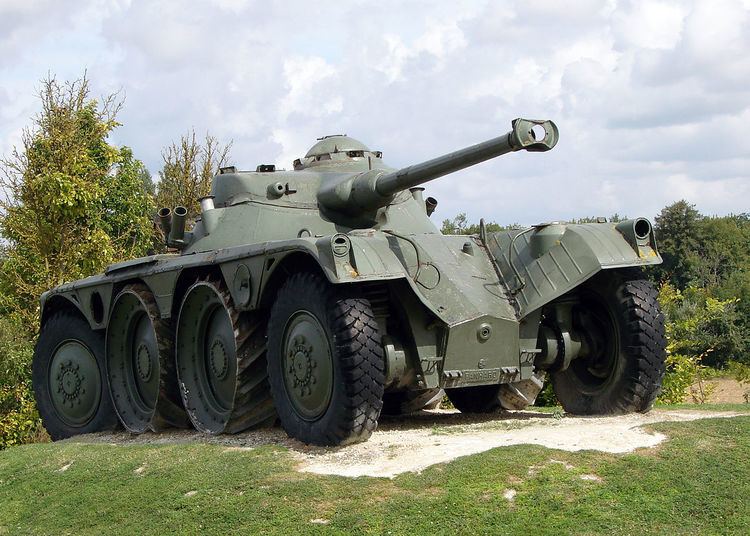Type Armoured car No. built 1200 | ||
 | ||
Wars Algerian WarPortuguese Colonial WarIndonesia-Malaysia Confrontation Weight 13 tonnes (14 short tons; 13 long tons) | ||
The Panhard EBR (Panhard Engin Blindé de Reconnaissance, French: Armored Reconnaissance Vehicle) is an armoured car designed by Panhard for the French Army and later used across the globe, notably by the French Army during the Algerian War and the Portuguese Army during the Portuguese Colonial War in Angola, Mozambique and Guinea-Bissau.
Contents
Description
The EBR is an 8x8 wheeled reconnaissance vehicle designed before the Second World War, but with production only commencing afterwards, with over 1200 vehicles being manufactured after 1954. While being lightly armoured, the EBR was armed with the 90 mm FL-11 or 75 mm cannon known as the FL-10 or L/48 in a novel oscillating turret and supported by up to four 7.5 mm machine guns, one co-axial, one operated by the driver, one by the co-driver and one by the commander, though the latter was not found on all EBRs. The EBR had a crew of four (including two in the turret), and was powered by a 200 hp (150 kW) 6 liter 12HD horizontally opposed air-cooled 12-cylinder engine (with dual carburetors and 6.6:1 compression, enabling it to run on low-octane petrol). Based on Panhard's two-cylinder automobile engine, it was mounted under the floor of the fighting compartment, which had the unfortunate effect of requiring the turret to be removed to conduct major engine repairs.
Designed in 1951 by Panhard, OBE used a symmetrical front and rear with two drivers positions. The EBR can reach speeds of 100 km/h (62 mph) on 14 in (36 cm)-wide, 24 in (61 cm)-diameter wheels with Michelin tyres and Veil-Picard tubes, which feature a series of nitrogen-filled cells, enabling them to absorb bullet hits and not go flat. The armoured hull is mounted on an 8-wheel drive, with 4 inner metal wheels, which can be raised for driving on the road. The four central wheels have aluminum rims with steel grousers, separated by rubber blocks; with all eight wheels deployed, ground pressure is only 0.7 kg (1.5 lb) per 1 cm2 (0.16 in2).
The 1954 model improves armaments with a lengthened 75 mm barrel, giving a muzzle velocity of 1000 m/s. Finally, the 1963 version further strengthens firepower with a 90 mm gun.
Particulars
France has, since 1935, engaged in the manufacture and use of a prolific line of wheeled armored reconnaissance vehicles armed with weapons with an anti-tank capability. This being the result of reforms initiated by the Light Mechanized Divisions (DLM).
French tactical doctrine required reconnaissance elements to cover and range over a large and extensive battlefield, especially within the context of the slow and high-maintenance tanks of the time. Also of note is the way that tanks are best deployed, massed and concentrated, which prevents their dispersion for safety and for screening.
So it is a particular trait with French reconnaissance vehicles to be heavily armed. From the prewar MD 178 armed with an anti-tank gun of 25 mm, (which was for the period a significant caliber for such a small vehicle) to the direct successor of the EBR, the AMX 10 RC, also used for wheeled reconnaissance, and armed with a powerful 105 mm gun with automatic firing, firepower equal to a main battle tank of the 1980s. A pattern repeated in the AML 90 and the ERC 90 Sagaie.
These reconnaissance systems are not only aimed at discovery and investigation (missions that can be fulfilled by lighter vehicles with lighter weapons), but also with security missions upon the battlefield (for example flank-security and offensive protection) which requires a substantial firepower not only to destroy the enemy advance elements, but also to oppose armoured incursions.
A turretless Panhard EBR vehicle carried the coffin of the late French president Charles de Gaulle at his state funeral.
